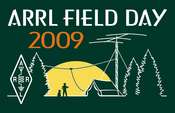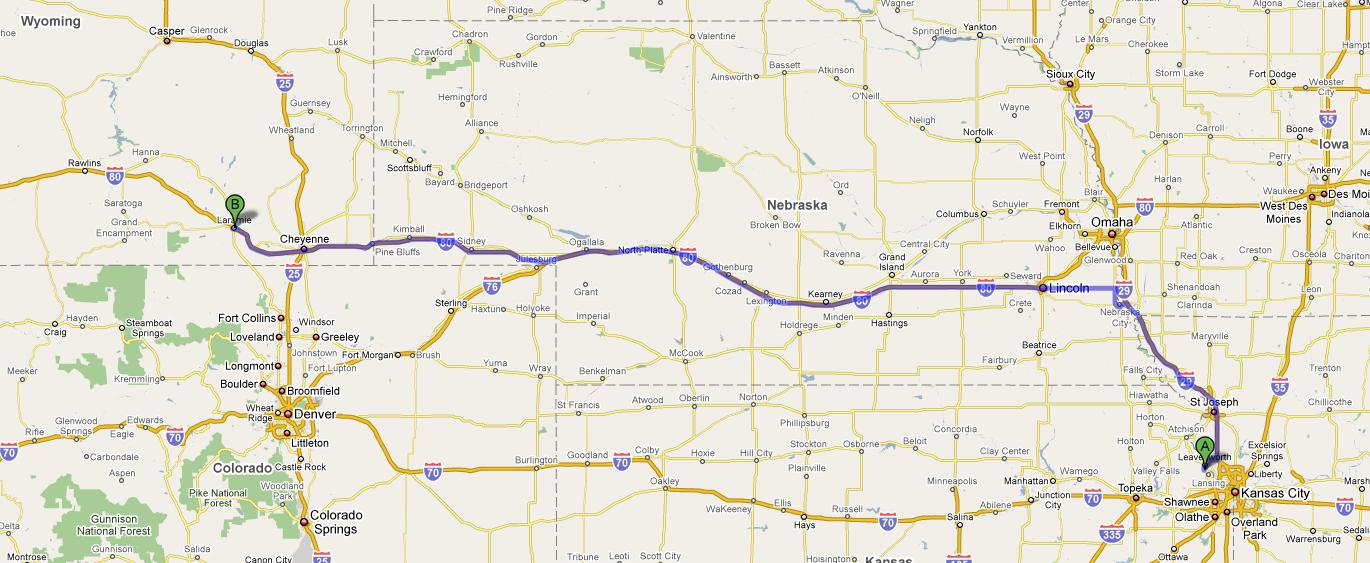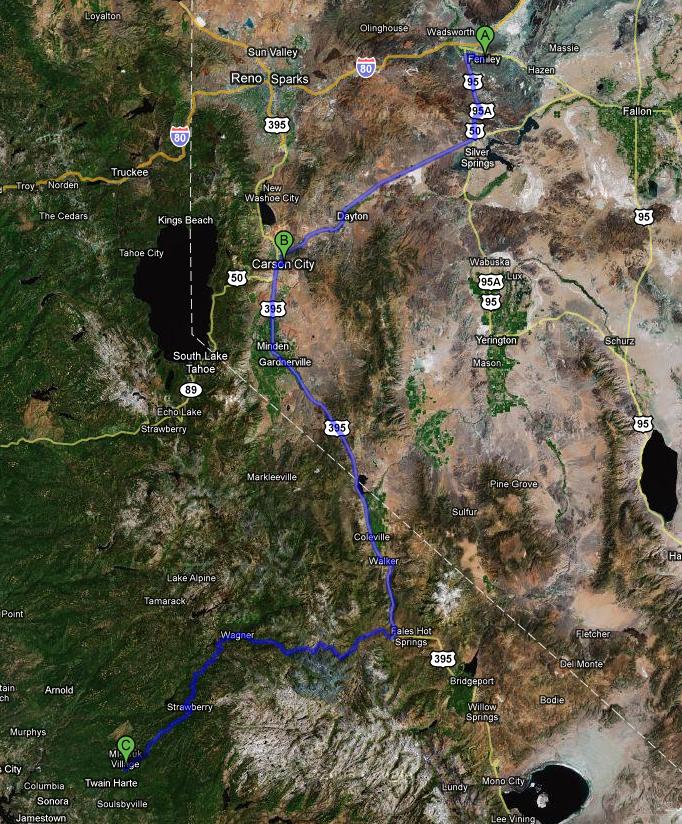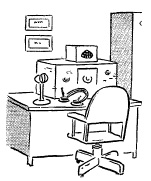 My Field Day adventure started on Tuesday, 23 June. I finished the final touched to the eARSIB and then through every possible item I thought I might need (minus a 25 pin to 9 pin cable for a Kantronics KPC-3+ which I will talk about later) in a total of 3 footlockers. I packed up the truck, loaded up the dog and was on the road by 10:30am. There was good APRS coverage on my route along I-80 up until western Nebraska where I encountered an almost 200 mile gap. Once I hit Cheyenne, I was back in APRS coverage. My stop for the first night was Laramie, Wyoming, which I made before sunset.
My Field Day adventure started on Tuesday, 23 June. I finished the final touched to the eARSIB and then through every possible item I thought I might need (minus a 25 pin to 9 pin cable for a Kantronics KPC-3+ which I will talk about later) in a total of 3 footlockers. I packed up the truck, loaded up the dog and was on the road by 10:30am. There was good APRS coverage on my route along I-80 up until western Nebraska where I encountered an almost 200 mile gap. Once I hit Cheyenne, I was back in APRS coverage. My stop for the first night was Laramie, Wyoming, which I made before sunset.

The next day I pushed on west. While in western Wyoming I was able to check into the 40M Sparkle Net (7262 kHz) and talk with Dave, KE0DL, back in Leavenworth, Kansas. I also noticed on my GPS that one of the APRS stations was moving along I-80 the same direction that I was going. I gave a short call on the 2M National Simplex frequency and got a reply. We had both started the drive in Wyoming but parted ways in Salt Lake; he headed south on I-15 to Vegas, I kept west on I-80. I enjoyed the drive through eastern Utah. Park City, Utah is a place I had spent a lot of time skiing about twenty years ago. I’d been there often in the winter, but this was the first time seeing it during the summer.

Traffic was heavy through Salt Lake City and I did my best to make my way around the city as quickly as possible. West of the Great Salt Lake, I had an interesting HF QSO with a gentleman in Southern California who was using an Elecraft K3 with an the diminutive MT-1 antenna. My initial plan was to spend the night in Winnemucca, Nevada but upon arriving discovered they had me on the second floor in a non-pet room. Instead of hauling my footlockers up a flight of stairs I decided to push on to Fernley, Nevada (just east of Reno) where I found a great hotel with a first floor room I could practically back my truck up into. The dog liked it too.

Thursday morning I worked my way up the eastern side of the Sierra Nevadas, listening to a few 40M nets. I reached the Sonora Pass around noon and enjoyed the view. The dog a I hiked up to a nearby plateau and took in the view.
After traveling down the western side of the mountains I was able to raise my dad, KD6EUG, on a repeater near his cabin in Mi-Wuk Village. California Hwy 108 wound its way down from Sonora Pass. The drive was spectacular along the scenic route and traffic was sparse. I rolled down the windows and opened the sun roof to take in gorgeous day. Reaching the cabin in Mi-Wuk, both the dog and I got to strech our legs and rest up. Thursday night we assembled the gear that would become a permanent station at the cabin: an IC-706MKIIG, LDG Z-11 Pro, RIGblaster PnP, IC-208H, all powered by an Icom PS-125. In addition to the radio gear, the station would also integrate a Davis Vantage Pro2 weather station, beaconing the weather data view APRS.

To simplify the APRS setup in the cabin, I decided to use a special add-on piece of equipment from Davis specifically designed to be used for APRS – the WeatherLink APRS streaming data logger. The data logger, once configured, streams weather data directly to a TNC, eliminating the need for a computer (or UI-View32). With this setup, it was not necessary to leave a computer running to keep the weather station pushing data to the TNC and VHF radio. The weather data is formated by the data logger to be ready for transmission into APRS. The station also has a laptop which I installed the WeatherLink software that would allow me to configure the APRS data logger. Configuring the data logger was pretty straight forward. Setting the parameters in the TNC to grab the data loggers APRS weather info proved a bit more challenging. The challenge was further compounded by my forgetting to pack the 25 pin to 9 pin cable that connects the laptop to the Kantronics KPC-3+ TNC.
The real work started Friday. The first task was completing the installation of a Davis Vantage Pro2 weather station on the cabin roof. That was done without much trouble.

The next step would be to get the weather data out via APRS using the IC-208H paired with the Kantronics KPC-3+ TNC and the Davis APRS streaming data logger. With the lack of a good cable to use between the laptop and TNC as well as not knowing exactly what parameters were need in the TNC we decided that task would have to wait until after Field Day.
Now it was time to string some antennas. The first was a 132′ dipole which ran N/S. I’d packed my CVS19 Pneumatic Antenna Launcher (aka tennis ball launcher) which helped us position the antenna up about 40′.

Next we strung a G5RV going E/W. This is the same G5RV I bought from a fellow ham when I lived back in Virginia. He had never used it and I had used the antenna only once while running a special event station at Fort Monroe.
It quickly became apparent that we could not both operate using both antennas due to their proximity to each other and surrounding powerlines prevented us from placing the antennas end to end in order to minimize interference. The solution: my dad’s Force 12 Sigma 5. The problem: the antenna was back in San Jose. So Friday night consisted of my dad traveling back to the Bay Area to retrieve the vertical antenna while I continued to configure the laptop (N3FJP Field Day networked logging software, Digipan for PSK-31, and the Davis Weatherlink program) in addition to setting up my operating position on the back deck of the cabin.

My operating position setup consisted of a 10’x10′ pop-up shelter (with mosquito net) and a large table with comfortable folding chair. Inside the shelter I placed a large table with the eARSIB and my station’s laptop.
I verified that the laptops at either operating position (the one inside the cabin and mine outside on the deck) could communicate via WiFi using the N3FJP software: it worked like a charm. The software allows two (or more) operating positions to share one log. Each operator gets to see the combined log and is notified of potential dupes.
Saturday morning my dad arrived back from the Bay Area and we setup the Sigma 5.

My operating position on the deck had the antenna connections for both the G5RV and the Sigma 5, my dad’s position had the 132′ ladderline-fed dipole. Interference between the two positions was sometimes a problem. I could use the Sigma 5 vertical on 20M, 15M, and 10M as long as my dad stayed on 80M or 40M (as long as I wasn’t on 15M). While this slowed down operations a bit, it gave us time to take plenty of breaks. My dad started Field Day by working PSK-31 on 20M. I worked phone contacts on 15M and 10M. Later my dad switched to phone, which he really started to enjoy.
10M and 15M were really incredible. I was able to work all the way to the East Coast and up and down the West Coast. For dinner, I BBQ’d some brauts. By midnight we were both exhausted and decided to get some rest.
I enjoyed using my eARSIB. This is the first time I used a foot pedal for my PTT – paired with a Heil headset. That worked great, allowing me to use both hands on the keyboard. I had been unable to configure the West Mountain RIGtalk to work on my laptop – not sure why. But it wasn’t too hard to just flip the band in the logging software. I had not used my Logikey CMOS4 Keyer in some time. I paired it with my Vibroplex paddle and the two worked well together. I enjoyed a few QRS CW QSOs – thank you for those who took the time to slow down for me. I had picked up a marine battery to use with my PWRgate and that worked well.
Sunday I got up after four hours of sleep and started working 80M using the G5RV.
The G5RV worked nicely and I contacted stations from Western Canada down to Southern California and Arizona. I moved up to 40M and expierenced similar results – but was also able to work a station in Japan. My dad was up soon and started to work on 80M and 40M with the 132′ dipole while I switched to the vertical and worked stations on 20M. By about 11:30am we were both pretty much spent. Overall we made about 250 contacts, mostly phone but also a few PSK-31 and CW…. and we had a great time!
KD6EUG Brags About The Number of QSOs He Made
We slept well Sunday night and Monday morning had me back working on the Kantronics KPC-3+/Davis weather station. The biggest problem I was having was figuring out what value to use for the GPSHEAD parameter. Without the correct value, the KPC-3+ was not grabbing the weather data. GPSHEAD would pull in the data a place it in LT (a buffer). LPT setup the APRS path. BLT setup the amount of time in between the TNC initiating a beacon transmission containing weather data.

After a few calls to the Davis headquarters, I was able to figure out that “@” was the magic value for GPSHEAD. Now the weather station is up and operational.

It was then back on the road, up and over the Sonora Pass. I was able to talk to my dad, operating from the Mi-Wuk cabin station, on 80M from the top of the pass. I spent the night in Carson City, Nevada and the next day headed east on I-80. I had made the decision to take I-70 back to Kansas in order to try something different as well as seeing a part of Colorado I had never seen before. It was a long haul to Grand Junction, Colorado – I arrived around midnight. After a few hours of sleep, I was on the road again heading east through some of the most beautiful scenery of the trip. Aspen and Veil were beautiful cities – I hope I get a chance to go back there someday. But while the drive was scenic, the going was slowed and progress was not nearly as quick as I had experienced before while moving through Wyoming and Nebraska.

I finally emerged from the Rockies and headed into Denver, stopping at the Ham Radio Outlet located there. Terry, KC0VFO, and I talked about our Field Day experiences – he operated mobile. His call sign looked familiar and sure enough, I had worked Terry on 15M during Field Day.
Moving east through Denver I was back on the open road, moving rapidly along I-70. I heard a call coming over the 2M National Simplex frequency. It was a gentleman operating from the Mt. Evans Observatory – we had an enjoyable QSO and he went on to work others. The Canada Day contest was also underway and I started to hand out contacts from the mobile. I had planned to make it all the way back to Leavenworth, Kansas but realized I was too tired and needed to spend the night somewhere. I crossed the Colorado/Kansas border and arrived in Goodland, Kansas were I found a hotel room and promptly fell fast asleep.
My final day on the road was pretty easy driving. When you think about Kansas, it is usually what you see in western Kansas along I-70. Flat terrain, lots of farms, not much else. For some reason, the speed limit max in Kansas drops to 70mph (Nebraska, Wyoming, Nevada, Utah, and Colorado all have a max of 75mph). I listened to some of the morning HF nets on 80M and 40M, then made contact with K2L, a special events station in Charleston, South Carolina. I was also able to check into the Sparkle Net on 40M and then later worked two stations on 17M, both located in and around the western border area between North and South Carolina. Soon I was back home, arriving before 3pm.







